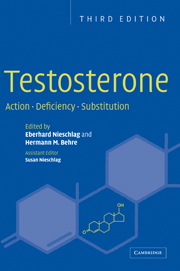Book contents
- Frontmatter
- Contents
- List of contributors
- Preface
- 1 Testosterone: an overview of biosynthesis, transport, metabolism and non-genomic actions
- 2 The androgen receptor: molecular biology
- 3 Androgen receptor: pathophysiology
- 4 Behavioural correlates of testosterone
- 5 The role of testosterone in spermatogenesis
- 6 Androgens and hair: a biological paradox
- 7 Androgens and bone metabolism
- 8 Testosterone effects on the skeletal muscle
- 9 Androgens and erythropoiesis
- 10 Testosterone and cardiovascular diseases
- 11 Testosterone and erection
- 12 Testosterone and the prostate
- 13 Clinical uses of testosterone in hypogonadism and other conditions
- 14 Pharmacology of testosterone preparations
- 15 Androgen therapy in non-gonadal disease
- 16 Androgens in male senescence
- 17 The pathobiology of androgens in women
- 18 Clinical use of 5α-reductase inhibitors
- 19 Dehydroepiandrosterone (DHEA) and androstenedione
- 20 Selective androgen receptor modulators (SARMs)
- 21 Methodology for measuring testosterone, DHT and SHBG in a clinical setting
- 22 Synthesis and pharmacological profiling of new orally active steroidal androgens
- 23 Hormonal male contraception: the essential role of testosterone
- 24 Abuse of androgens and detection of illegal use
- Subject Index
4 - Behavioural correlates of testosterone
Published online by Cambridge University Press: 18 January 2010
- Frontmatter
- Contents
- List of contributors
- Preface
- 1 Testosterone: an overview of biosynthesis, transport, metabolism and non-genomic actions
- 2 The androgen receptor: molecular biology
- 3 Androgen receptor: pathophysiology
- 4 Behavioural correlates of testosterone
- 5 The role of testosterone in spermatogenesis
- 6 Androgens and hair: a biological paradox
- 7 Androgens and bone metabolism
- 8 Testosterone effects on the skeletal muscle
- 9 Androgens and erythropoiesis
- 10 Testosterone and cardiovascular diseases
- 11 Testosterone and erection
- 12 Testosterone and the prostate
- 13 Clinical uses of testosterone in hypogonadism and other conditions
- 14 Pharmacology of testosterone preparations
- 15 Androgen therapy in non-gonadal disease
- 16 Androgens in male senescence
- 17 The pathobiology of androgens in women
- 18 Clinical use of 5α-reductase inhibitors
- 19 Dehydroepiandrosterone (DHEA) and androstenedione
- 20 Selective androgen receptor modulators (SARMs)
- 21 Methodology for measuring testosterone, DHT and SHBG in a clinical setting
- 22 Synthesis and pharmacological profiling of new orally active steroidal androgens
- 23 Hormonal male contraception: the essential role of testosterone
- 24 Abuse of androgens and detection of illegal use
- Subject Index
Summary
Introduction
Behavioural endocrinology is the study of the interaction between hormones and behaviour. This interaction is bidirectional: hormones can affect behaviour, and behaviour can alter hormone levels. Thus, hormonal-behavioural correlations can be due to hormonal effects on behaviour, but certain behaviour (such as physical exercise, stress, sexual behaviour, alcohol consumption, and nutrition) is known to influence hormone levels as well (see below and Christiansen 1999).
Hormones do not cause behavioural changes per se; they can only alter the probability that particular behaviour will occur in the presence of a particular stimulus. Hormones can influence regions of the central nervous system (CNS) which contain hormone receptors by inducing changes in the rate of cellular function. The interaction of a hormone with its receptor begins a series of cellular events that lead to a genomic response wherein the hormone acts directly or indirectly to activate genes that regulate protein synthesis (e.g., Bixo et al. 1995; Chalepakis et al. 1990; Ford and Cramer 1982; Genazzani et al. 1992; Hutchinson 1991; McEwen 1992; McEwen et al. 1984; Sekeris 1990; Viru 1991).
Two decisive phases have been named in the discussion about the time of the effects of sex hormones on brain structures and consequently on behaviour. During fetal and neonatal life, relatively high concentrations of hormones, especially testosterone, are said to influence brain development by organizing the undifferentiated brain in a sex-specific manner.
- Type
- Chapter
- Information
- TestosteroneAction, Deficiency, Substitution, pp. 125 - 172Publisher: Cambridge University PressPrint publication year: 2004
- 8
- Cited by

